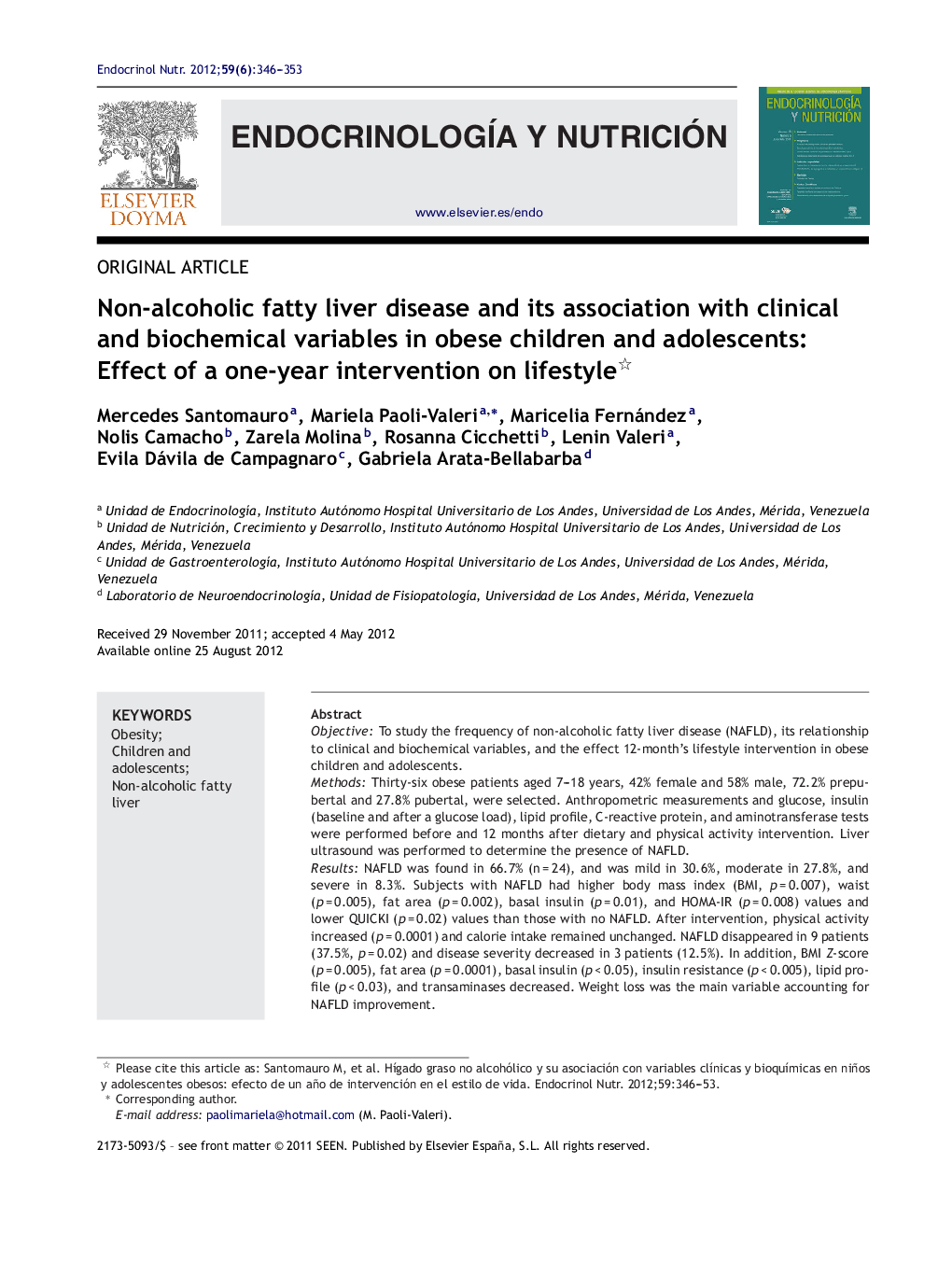| کد مقاله | کد نشریه | سال انتشار | مقاله انگلیسی | نسخه تمام متن |
|---|---|---|---|---|
| 3267259 | 1207979 | 2012 | 8 صفحه PDF | دانلود رایگان |

ObjectiveTo study the frequency of non-alcoholic fatty liver disease (NAFLD), its relationship to clinical and biochemical variables, and the effect 12-month's lifestyle intervention in obese children and adolescents.MethodsThirty-six obese patients aged 7–18 years, 42% female and 58% male, 72.2% prepubertal and 27.8% pubertal, were selected. Anthropometric measurements and glucose, insulin (baseline and after a glucose load), lipid profile, C-reactive protein, and aminotransferase tests were performed before and 12 months after dietary and physical activity intervention. Liver ultrasound was performed to determine the presence of NAFLD.ResultsNAFLD was found in 66.7% (n = 24), and was mild in 30.6%, moderate in 27.8%, and severe in 8.3%. Subjects with NAFLD had higher body mass index (BMI, p = 0.007), waist (p = 0.005), fat area (p = 0.002), basal insulin (p = 0.01), and HOMA-IR (p = 0.008) values and lower QUICKI (p = 0.02) values than those with no NAFLD. After intervention, physical activity increased (p = 0.0001) and calorie intake remained unchanged. NAFLD disappeared in 9 patients (37.5%, p = 0.02) and disease severity decreased in 3 patients (12.5%). In addition, BMI Z-score (p = 0.005), fat area (p = 0.0001), basal insulin (p < 0.05), insulin resistance (p < 0.005), lipid profile (p < 0.03), and transaminases decreased. Weight loss was the main variable accounting for NAFLD improvement.ConclusionThis group of obese children and adolescents showed a high frequency of NAFLD. The lifestyle intervention with weight reduction is effective for the treatment of NAFLD.
ResumenObjetivoEstudiar la frecuencia de hígado graso no alcohólico (HGNA), su relación con variables clínicas y bioquímicas, y el efecto de la intervención durante 12 meses en el estilo de vida en niños y adolescentes obesos.MétodosSe seleccionaron 36 pacientes obesos entre 7 y 18 años, 42% femeninos y 58% masculinos, 72,2% prepuberales y 27,8% puberales. Antes y 12 meses después de intervención sobre dieta y actividad física, se tomaron medidas antropométricas y se cuantificaron glucosa e insulina (basal y poscarga de glucosa), perfil lipídico, proteína C reactiva y aminotransferasas. Se realizó ecografía hepática para determinar presencia de HGNA.ResultadosEl 66,7% (n = 24) presentó HGNA, 30,6% de grado leve, 27,8% moderado y 8,3% grave. Aquellos con HGNA tenían índice de masa corporal (IMC; p = 0,007), circunferencia abdominal (p = 0,005), área grasa (p = 0,002), insulina basal (p = 0,01) y HOMA-IR (p = 0,008) más altos, y QUICKI (p = 0,02) más bajo, que aquellos sin HGNA. Con la intervención, la actividad física aumentó (p = 0,0001) y la ingesta calórica se mantuvo igual; el HGNA desapareció en 9 pacientes (37,5%; p = 0,02) y en 3 mejoró el grado de alteración (12,5%). Además, el Z-Score del IMC (p = 0,005), el área grasa (p = 0,0001), la insulina basal (p < 0,05), la resistencia a la insulina (p < 0,005), el perfil lipídico (p < 0,03) y las transaminasas disminuyeron. La disminución de peso fue la principal variable explicativa de la mejoría del HGNA.ConclusiónEn este grupo de niños y adolescentes obesos se observó una alta frecuencia de HGNA. La intervención en estilo de vida con reducción de peso es efectiva en el tratamiento del HGNA.
Journal: Endocrinología y Nutrición (English Edition) - Volume 59, Issue 6, June–July 2012, Pages 346–353